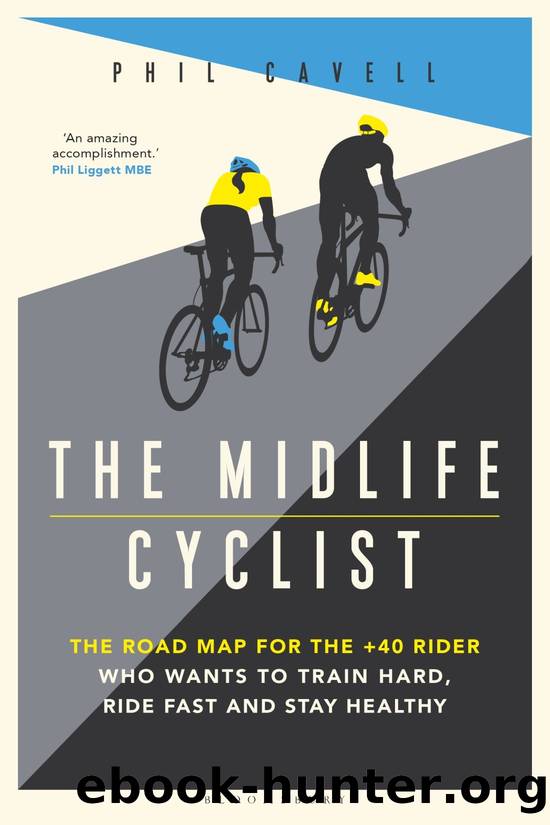The Midlife Cyclist: The Road Map for the +40 Rider Who Wants to Train Hard, Ride Fast and Stay Healthy by Phil Cavell

Author:Phil Cavell [Cavell, Phil]
Language: eng
Format: epub
Tags: Sports & Recreation, Cycling, Health & Fitness, Exercise, General, Medical, physiology, Research
ISBN: 9781472961396
Google: YWMhEAAAQBAJ
Publisher: Bloomsbury Publishing
Published: 2021-06-24T23:53:36.679270+00:00
5
Bikes, Bike Fit and Biomechanics
Nobody hates the âJâ word more than I, where âJâ stands for âjourneyâ and is normally preceded by the word âpersonalâ and includes details of a yoga retreat or week-long silence in a monastic cell. But itâs clear that as midlife cyclists, we have to acknowledge lifeâs arc and the changes that are inevitably happening within our bodies and minds as we get older. And while itâs true that exercise, and especially high-level exercise, does bring huge physiological and cognitive benefits and protection, itâs also true that we can run the risk of having too much of a good thing, which can result in injury and illness. As weâve learned from chapter 2, the bicycle inherently has so much to recommend it to midlife athletes in terms of joint protection and muscle trauma, compared to running, rugby and squash, etc. But the legacy of the fundamentals of cycling biomechanics which the Victorians kindly bequeathed us, and which was eternally and some (OK, I) would say unhelpfully preserved in aspic by the UCI, creates challenges that need to be continually considered if you want to stay healthy, fit and meet your goals as you age. In short, human beings didnât evolve to ride bikes, whatever the Victorian gentlemen inventors thought or intended at the time. In this chapter we explore the practical aspects of the relationship between the bike and the midlife body and how it can be preserved, or even improved, as we elegantly age.
In chapter 2 we interlocked Alex Fugalloâs hypermobileâstiffness spectrum with Phil Burtâs micro-adjusterâmacro-absorber spectrum. And I invited you to think of where you sit on both. Are you a princess with her pea on the bike? Or can you ride anything, anywhere and never feel a moment of pain or discomfort? Do you struggle with flexibility? Or are you naturally abundant in your joint muscle ranges and always have been? You should have an idea where you sit on those two scales (no self-delusion, please â it wonât help anyone). In this chapter, weâll look in more detail at the biomechanical interface between the human and the bicycle and how this relationship can change over time.
The perfect cycling body
Before we look at what can go wrong in the body-to-bike relationship department, it might be interesting to think about the perfect cycling physique. In our opinion anyway. Bear in mind that the bike is, by definition, at least to start with, entirely symmetrical â cycling therefore rewards symmetry, or at the very least one needs to know where someone exhibits asymmetry, to potentially intervene with a compensation. For example, weâve worked with many athletes, including professional cyclists, who exhibit a spinal scoliosis â an S-shape in the spine, when viewed from the back. None of us are robots of course (one of our favourite aphorisms in the fit studio), so all of us have little kinks and irregularities in our morphology, but itâs a question of extent. An extreme scoliosis can take the head, shoulders, hands, arms and even hips and legs out of alignment.
Download
This site does not store any files on its server. We only index and link to content provided by other sites. Please contact the content providers to delete copyright contents if any and email us, we'll remove relevant links or contents immediately.
Spare by Prince Harry The Duke of Sussex(5077)
Machine Learning at Scale with H2O by Gregory Keys | David Whiting(4192)
Fairy Tale by Stephen King(3221)
Will by Will Smith(2795)
Hooked: A Dark, Contemporary Romance (Never After Series) by Emily McIntire(2502)
The Bullet Journal Method by Ryder Carroll(2487)
Rationality by Steven Pinker(2291)
Can't Hurt Me: Master Your Mind and Defy the Odds - Clean Edition by David Goggins(2230)
It Starts With Us (It Ends with Us #2) by Colleen Hoover(2203)
Friends, Lovers, and the Big Terrible Thing by Matthew Perry(2126)
The Becoming by Nora Roberts(2091)
Love on the Brain by Ali Hazelwood(1965)
HBR's 10 Must Reads 2022 by Harvard Business Review(1779)
The Strength In Our Scars by Bianca Sparacino(1778)
A Short History of War by Jeremy Black(1764)
Leviathan Falls (The Expanse Book 9) by James S. A. Corey(1651)
515945210 by Unknown(1602)
A Game of Thrones (The Illustrated Edition) by George R. R. Martin(1594)
Bewilderment by Richard Powers(1541)
